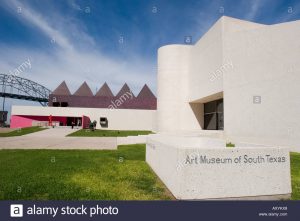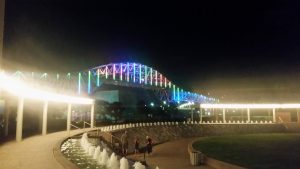Finding your love for your hometown is something that you gently fall into. When you’re there, its easy to hate it — you can see up close the flaws and shortcomings that you learn to live with. It seems often that things will not change. That every weekend, there will be nothing to do, that the construction will never end yet the roads will never be fixed. My hometown, Corpus Christi, is precisely like this. And yet, after taking a walk in San Antonio’s historic West Side, I began to reflect on the historical architecture present in Corpus, and it is in this reflection that I realized how little I knew. Thus, I began to dig a bit deeper into the architectural monuments I so easily took for granted.
Heritage Park
Just as the name would suggest, Heritage Park showcases twelve Corpus Christi homes of historical significance, dating all the way back to 1851 (The Merriman‐Bobys House). Between them, one can see architecture ranging from Victorian to Colonial, speaking to the diversity not only of the structures themselves, but the long-gone inhabitants that are a testament to the diversity of the Bay Area. Members of the NAACP, co-founders of LULAC, Mexican-Americans, Irish-Americans, African-Americans… the whole array can be seen represented in Heritage Park, not for the superficial reason of ‘inclusion’, but because the original owners of these homes made their mark in the coastal bend community.
What pains me about Heritage Park is that very little work has been done in terms of bringing this fascinating history to the public. A quick search for ‘Heritage Park’ reveals that the historic site has no website, no social media — hardly a trace! It is only within the last few days that I learned the park itself was used for anything other than special events. Sure, most Corpus Christians know of the historical site, but of its history? What a tragedy! Most of the online reviews are about the types of pokemon you can find there on Pokemon Go! All this to say, taking this Public History course has allowed me to appreciate Heritage Park much more, and additionally it has allowed me to realize how desperately it is in need of a good public historian.
The Art Museum of South Texas
Any art museum houses hundreds of individual pieces of breathtaking art. But can the building itself be called art? Only naturally. At the Art Museum of South Texas much care has been put into the architecture of the two buildings — one from 1972, one from 2006. The original building, crafted by Philip Johnson is a love letter to the region, constructed of shells, sand, and concrete (a.k.a. shellcrete) and fashioned into a castle reminiscent of adobe style homes, perfect for keeping the sticky heat and humidity away from the precious pieces within. Much of this I knew, as my mother was once obsessed with the structure of the museum, pulling out her little architecture book and flipping to the page that featured our hometown museum any time it would come up in conversation with our guests.

The Harbor Bridge
Of all the interesting and historic architecture in Corpus, however, there is one thing that stands apart — the iconic Harbor Bridge, and its skeleton-like silhouette. Finished in 1959, it stands at 243 ft. tall. (You can see more specs here. ) But despite its iconic status and sixty years of service, the end is nigh for this beloved Corpus Christi monument. My grandmother would describe how she used to take a ferry boat across the channel that the Harbor Bridge connects, and that the bridge brought that era to an end. Nowadays it seems as though the bridge will now be left in the dust, a plan for a new bridge already being put into action, its completion expected in 2021.

In conclusion, I prompt my readers to think about the architecture of their hometown, wherever that may be. There’s no town too small or city too big not to have key buildings that made an impression on you, whether you hung around them very much or not. Leave a comment telling me where you’re from and which buildings remind you most of your life growing up, or which you consider ‘classic hometown’.

This was a really interesting piece. I was recently reading a book that had a lot to deal with new age Mexican architecture, and it’s really interesting to see that many of their postmodern designs have a very distinct feel to it that only belongs to Mexican culture.
I’m from D.C/Georgetown so my whole neighborhood was a bunch of monuments that I took for granted. My favorite wasn’t a monument at all, but rather a street near my own that was built in the 1790’s, and had old Victorian homes next to high rises. What made it really special is because of how old the city was, and how certain parts of it were zoned. Some houses only had 2-3 inches of space between them, so when I say the old Victorian was next to a high rise, I mean it was really right next to it.
It’s a shame to hear about the bridge, but replacing it seems pretty pragmatic. History bends before commerce, at least when governments are involved.
Wow Glory, thank you for sharing this insightful moment. Even with my archeological experience I have taken most of the architecture in my hometown. After reading this, I went to see the historic district of my community and then even though of the old barns that I can see on some of the hundred-year-old ranches. I then started thinking of the significance that these structures once had that have faded into memory. I actually found out that one old home was a hospital for returning WWI solider, however there is no documentation insight, only stories of the new house owners. And the historic buildings in my community are being funded by Oil Field Money…. I digress. Your blog was thoughtful and made me aware of issues that I did not even know about. Thank you!
Great write up of what makes a home town special. Sometimes we become busy with life that we often forget to stop and admire the little things that make the world such a nice place to live in. the things we see every day become mundane and we lose sight of how beautiful they are. We should always take some time to pause and admire the the uniqueness of the things around us.
You know, I find things like this happening more and more in my own city. I’ll be quite honest, I didn’t visit many of the sites in San Antonio that are considered unique and interesting in terms of history until it became “cool” and “exciting” to visit. The new “Southtown” of San Antonio included Blue Star Brewery and surrounding area, The Guenther House Restaurant and Museum, as well as Franks (recently closed down) and these places only recently became the spot to visit in San Antonio. This surprised me because places like the King Williams District have always been a spot for visitors and tourists to take a glance at and visit. It makes me a bit sad that these beautiful places are only now coming back but the history of these places are pretty unknown to the patrons…
Oh man, my heart. It wasn’t until I left Corpus for San Antonio that I began to appreciate the nuances that make Corpus, Corpus. You hit the nail on the head when you said that the city is in need of a public historian. I learned more about Heritage Park in your post than in the 18 years I lived there. There’s a definite struggle between preserving, improving, and even acknowledging the history that this city has to offer and with the newfound knowledge I’m acquiring, I almost feel obligated to give back to the city that formed so much of who I am. I remember saying, countless times, “this city never changes.” Some of what hasn’t changed should be preserved, and what is being lost should be properly remembered. Thank you for posting this and reminding me of where the heart is.
I never really was a fan of architecture, not even in my own hometown of San Antonio. Looking at this article I see it makes a huge impact on the author and it intrigues me to go try it myself. It is amazing the connection this author has with his mother over architecture. One of the colder and straightforward subjects in my own head. That these buildings house so much feeling and memories of the locals is wonderful. I believe this could be a wonderful segway into history for many and to take pride in their hometown history when they have something tangible like a building.